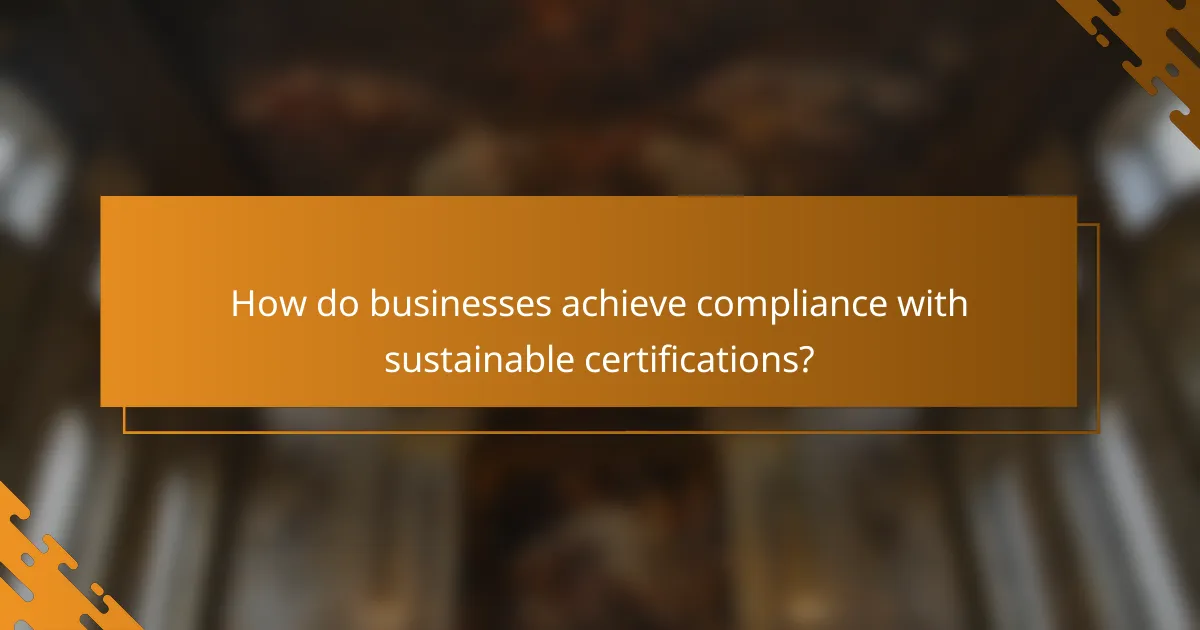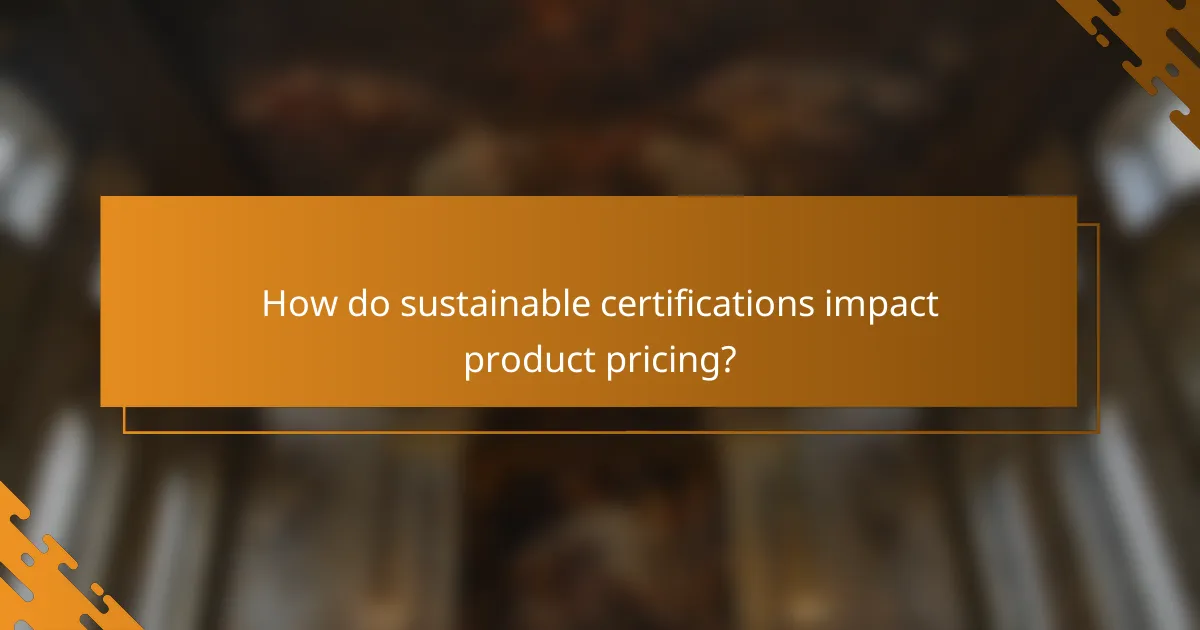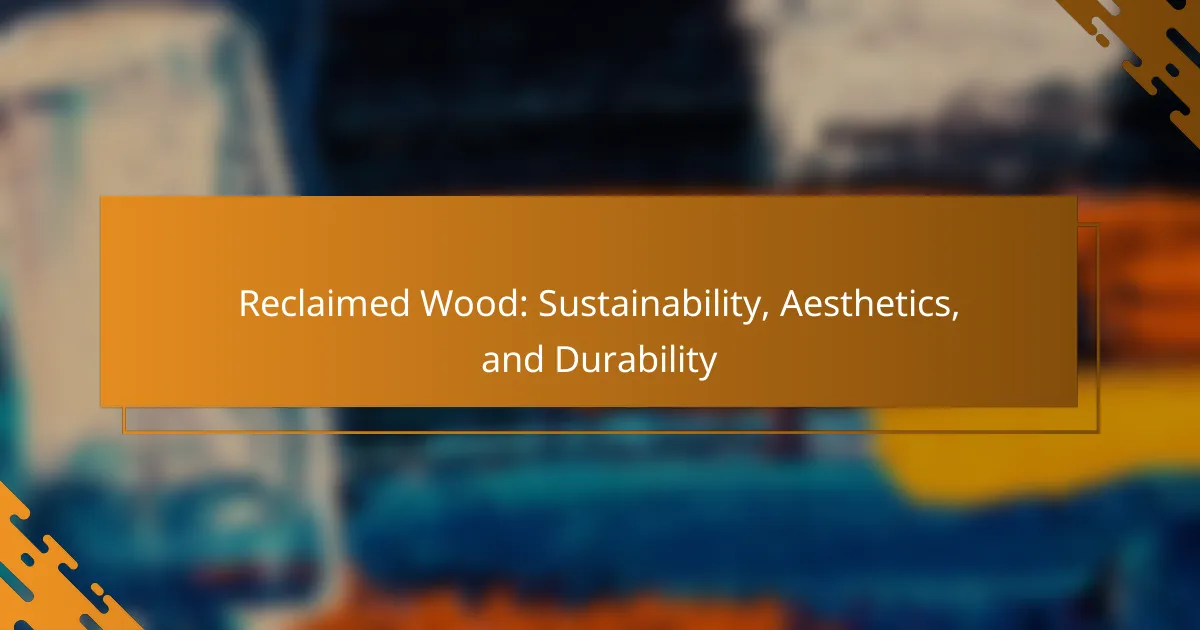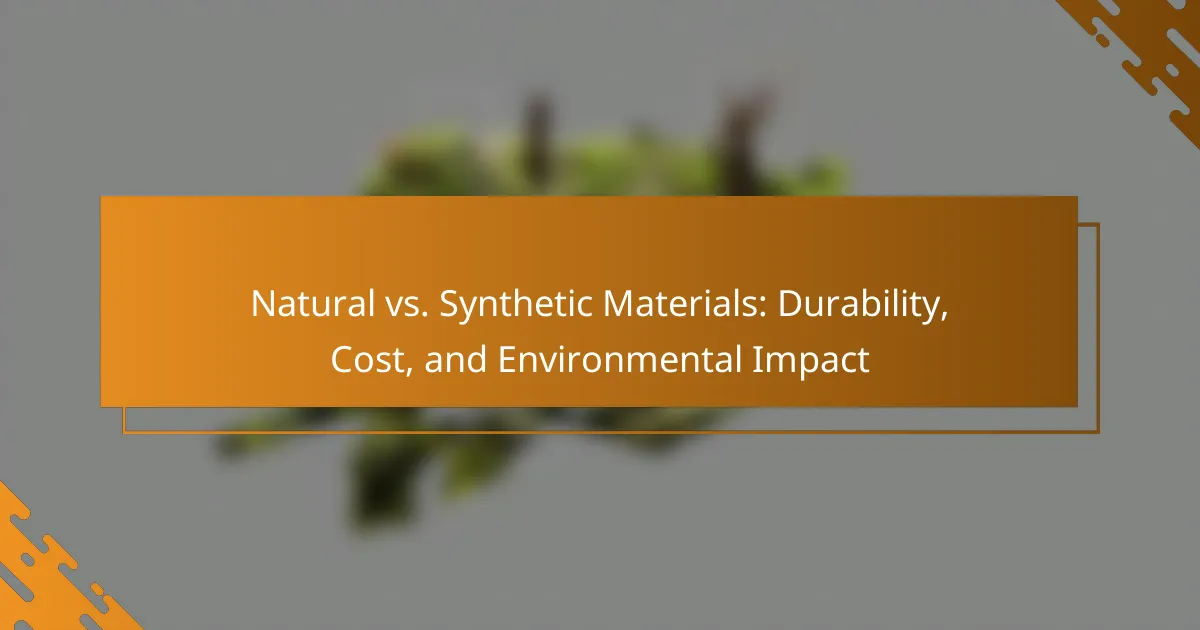Sustainable material certifications are essential standards that confirm products adhere to specific environmental and social criteria. By providing transparency, these certifications empower consumers to make informed choices while encouraging manufacturers to implement eco-friendly practices, ultimately fostering a more sustainable marketplace.

What are the types of sustainable material certifications?
Sustainable material certifications are standards that verify products meet specific environmental and social criteria. These certifications help consumers make informed choices and encourage manufacturers to adopt eco-friendly practices.
Global Organic Textile Standard (GOTS)
The Global Organic Textile Standard (GOTS) is a leading certification for organic textiles, ensuring that materials are made from at least 70% organic fibers. It covers the entire supply chain, from harvesting raw materials to production processes, labeling, and environmental impact.
To achieve GOTS certification, companies must comply with strict environmental and social criteria, including the prohibition of toxic chemicals and the implementation of fair labor practices. This certification is recognized globally, making it a trusted choice for consumers seeking sustainable textiles.
Forest Stewardship Council (FSC)
The Forest Stewardship Council (FSC) certification ensures that wood and paper products come from responsibly managed forests. This certification promotes sustainable forestry practices that protect ecosystems and support local communities.
FSC offers different labels, such as FSC 100% for products made entirely from certified wood, and FSC Mix, which contains a mix of certified and controlled materials. When purchasing wood products, look for the FSC logo to ensure sustainable sourcing.
Cradle to Cradle Certified
Cradle to Cradle Certified is a comprehensive certification that evaluates products based on their environmental and social performance across several categories, including material health, material reutilization, renewable energy, water stewardship, and social fairness. This certification encourages a circular economy by promoting products designed for reuse and recycling.
Products can achieve different levels of certification: Basic, Bronze, Silver, Gold, and Platinum, depending on their performance in these categories. Companies aiming for this certification should focus on innovative design and sustainable material choices.
OEKO-TEX Standard 100
The OEKO-TEX Standard 100 is a certification for textiles that tests for harmful substances, ensuring that products are safe for human health. This certification applies to all stages of textile production, from raw materials to finished products.
Textiles certified under this standard are tested for over 100 harmful substances, including pesticides and heavy metals. Consumers can look for the OEKO-TEX label to ensure the textiles they purchase are free from harmful chemicals and safe for use.
LEED Certification
LEED (Leadership in Energy and Environmental Design) certification is a widely recognized green building certification that evaluates the sustainability of buildings and their materials. It focuses on energy efficiency, water usage, indoor environmental quality, and sustainable site development.
LEED certification can be achieved at various levels: Certified, Silver, Gold, and Platinum, depending on the number of points earned through sustainable practices. When selecting materials for construction or renovation, consider those that contribute to LEED points to enhance sustainability and reduce environmental impact.

Why are sustainable material certifications important?
Sustainable material certifications are crucial as they verify that products meet specific environmental and ethical standards. These certifications help businesses demonstrate their commitment to sustainability, which can lead to various benefits, including improved marketability and compliance with regulations.
Environmental impact reduction
Sustainable material certifications contribute to environmental impact reduction by ensuring that materials are sourced responsibly and produced with minimal harm to ecosystems. For instance, certifications like FSC (Forest Stewardship Council) for wood products ensure that forests are managed sustainably, promoting biodiversity and reducing deforestation.
By choosing certified materials, companies can lower their carbon footprint and waste generation. This not only benefits the planet but can also lead to cost savings in the long run through more efficient resource use.
Consumer trust and brand loyalty
Certifications enhance consumer trust by providing transparency about the sourcing and production processes of materials. When customers see recognized certifications, they are more likely to believe that a brand is committed to ethical practices.
Building brand loyalty through sustainable practices can lead to increased customer retention and potentially higher sales. Brands that prioritize sustainability often attract environmentally conscious consumers, making certifications a valuable marketing tool.
Regulatory compliance
Many regions have regulations that require businesses to adhere to certain sustainability standards. Certifications can help companies demonstrate compliance with these laws, avoiding potential fines and legal issues. For example, the EU has stringent regulations on the use of hazardous materials, and certifications can help ensure compliance.
Staying ahead of regulatory requirements through certifications can also provide a competitive advantage. Companies that proactively adopt sustainable practices are often better positioned to adapt to changing regulations and market demands.

How do businesses achieve compliance with sustainable certifications?
Businesses achieve compliance with sustainable certifications by adhering to specific standards set by certifying bodies. This involves understanding the requirements, implementing sustainable practices, and undergoing regular audits to ensure ongoing compliance.
Understanding certification requirements
To comply with sustainable certifications, businesses must first familiarize themselves with the specific criteria established by the certifying organizations. These requirements often include guidelines on resource usage, waste management, and social responsibility.
For example, certifications like LEED for buildings or FSC for forestry have distinct criteria that must be met. Companies should review these standards thoroughly to identify which areas of their operations need improvement.
Implementing sustainable practices
Once the requirements are understood, businesses should integrate sustainable practices into their operations. This can include reducing energy consumption, sourcing materials responsibly, and minimizing waste through recycling and reuse.
Practical steps might involve investing in energy-efficient equipment or establishing partnerships with suppliers who prioritize sustainability. Companies should also engage employees in sustainability initiatives to foster a culture of environmental responsibility.
Regular audits and assessments
Regular audits and assessments are crucial for maintaining compliance with sustainable certifications. These evaluations help businesses identify areas for improvement and ensure they are meeting the established standards.
Companies should schedule audits at least annually, but more frequent assessments can be beneficial. Engaging third-party auditors can provide an objective review of practices and help in addressing any compliance gaps effectively.

What are the costs associated with obtaining certifications?
Obtaining sustainable material certifications involves various costs that can significantly impact a business’s budget. These costs typically include certification fees, operational changes, and expenses related to training and education.
Certification fees
Certification fees can vary widely depending on the type of certification and the certifying body. Businesses may encounter initial application fees, annual renewal fees, and additional costs for audits, which can range from a few hundred to several thousand dollars. It’s essential to research specific certifications to understand the total financial commitment involved.
Some certifications may offer tiered pricing based on the size of the company or the volume of materials certified. For example, smaller businesses might pay lower fees compared to larger corporations, making it crucial to evaluate options that align with your budget.
Operational changes
Implementing sustainable practices to meet certification standards often requires operational changes, which can incur additional costs. This may involve upgrading equipment, modifying supply chains, or investing in new technologies to ensure compliance with sustainability criteria. These changes can lead to both direct and indirect expenses.
For instance, transitioning to eco-friendly materials might increase initial costs but can result in long-term savings through improved efficiency and reduced waste. Businesses should weigh the upfront investment against potential savings and benefits over time.
Training and education expenses
Training employees on sustainable practices and compliance requirements is another cost associated with obtaining certifications. This may involve workshops, seminars, or online courses, which can range from a few hundred to several thousand dollars, depending on the depth and breadth of training needed.
Investing in employee education not only helps in achieving certification but also fosters a culture of sustainability within the organization. Companies should consider ongoing training as part of their operational budget to ensure that staff remains informed about best practices and regulatory changes.

How do sustainable certifications impact product pricing?
Sustainable certifications can significantly influence product pricing by adding costs related to compliance and production processes. These certifications often require investments in sustainable practices, which can lead to higher prices for consumers.
Higher production costs
The process of obtaining sustainable certifications typically involves higher production costs. Manufacturers may need to invest in eco-friendly materials, implement new technologies, or undergo extensive audits to meet certification standards. This can increase the overall cost of goods sold, which may be passed on to consumers.
For example, a company producing organic textiles might face costs that are 10-30% higher than conventional production methods due to the need for certified organic fibers and sustainable dyeing processes. These additional costs can lead to higher retail prices for certified products.
Market demand influences
Market demand for sustainable products can also impact pricing. As consumers increasingly prioritize eco-friendly options, companies may raise prices based on perceived value. High demand for certified products can justify premium pricing, especially in markets where sustainability is a key purchasing factor.
In regions like Europe and North America, where consumers are willing to pay more for sustainable goods, brands may price their certified products 15-50% higher than non-certified alternatives. This reflects both the added costs of certification and the willingness of consumers to invest in environmentally responsible choices.



